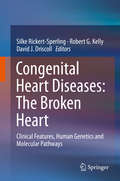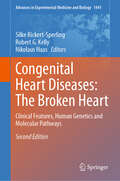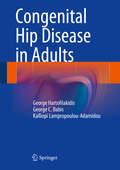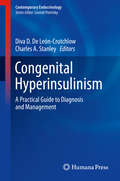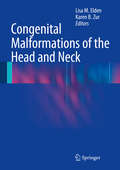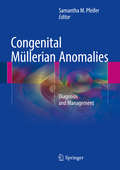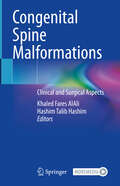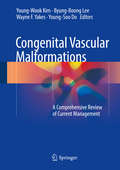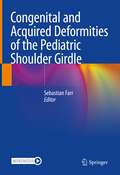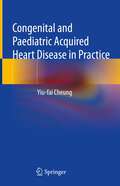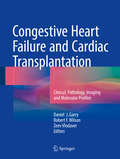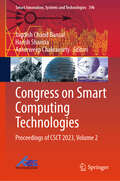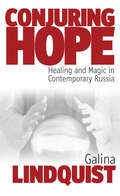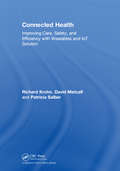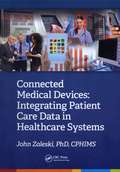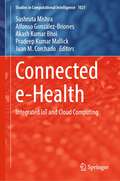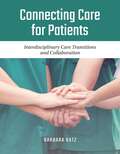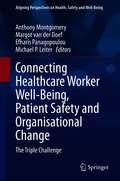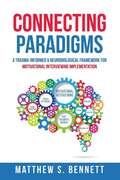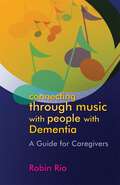- Table View
- List View
Congenital Heart Diseases in Adults: Imaging and Diagnosis (Medical Radiology)
by Sebastian Ley Julia Ley-ZaporozhanThis book presents a systematic overview of the most common cardiovascular defects as they are observed in adults, with a particular focus on the long-term effects and issues that may arise following surgical or interventional repair. In-depth information is provided on the standard of repair or palliation and on the role of different imaging techniques, especially CT and MRI, in the evaluation of these patients. Each chapter includes a detailed imaging protocol and describes the management appropriate to particular conditions and circumstances. Congenital heart disease (CHD) is one of the most common inborn defects. The success in treating CHD in children, even when they have complex cardiovascular defects, is resulting in a steady increase in the number of adults with CHD who need to be followed up clinically and by imaging owing to the potential for late sequelae. In providing expert, up-to-date guidance on selection of imaging modality, image interpretation, and management, this book will be a valuable resource for all radiologists, cardiologists, and pediatricians who are responsible for the care of adult and adolescent patients with CHD.
Congenital Heart Diseases: Clinical Features, Human Genetics and Molecular Pathways
by Silke Rickert-Sperling Robert G. Kelly David J. DriscollThis book provides comprehensive insights into congenital heart disease from embryonic development through to clinical features, including human genetics and our current knowledge of the underlying molecular pathways. It is divided into three parts: an introduction to the development of the heart and its vessels, an overview of the molecular pathways affecting the development of various cardiovascular structures, and a main section focusing on the different types of structural and nonstructural congenital heart diseases, including their clinical features, underlying genetic alterations and related animal models and pathways. Taken together these chapters, which were written by and for clinicians and researchers, provide an integrated and cutting-edge resource for all those who want to learn more about both the clinical aspects and the genetic and molecular basis of congenital heart disease.
Congenital Heart Diseases: Clinical Features, Human Genetics and Molecular Pathways (Advances in Experimental Medicine and Biology #1441)
by Silke Rickert-Sperling Robert G. Kelly Nikolaus HaasThis 2nd edition has been extensively updated and provides comprehensive and current insight into congenital heart diseases, from embryonic development through to clinical features, including human genetics and our current knowledge of the underlying molecular pathways.The book is divided into three parts: an introduction to the development of the heart and its vessels, an overview of the molecular pathways affecting the development of various cardiovascular structures, and a main section focusing on the different types of structural and nonstructural congenital heart diseases, including their clinical features, underlying genetic alterations and insights from animal models and pathways. All chapters have been updated and new chapters added on state-of-the-art approaches including stem cells and organoids, cardiac metabolism, single cell transcriptomics and 3D reconstruction of human heart development. The clinical chapters have been extended and include new sections on diagnostic imaging techniques. Taken together, the book, written by and for clinicians and researchers, provides an integrated and up-to-date resource for all those who want to learn more about both the clinical aspects and the genetic and molecular basis of congenital heart disease.
Congenital Hip Disease in Adults
by George Hartofilakidis George C. Babis Kalliopi Lampropoulou-AdamidouCongenital hip disease (CHD) is the main cause of secondary osteoarthritis (OA) of the hip in young adults, which accounts for almost 40% of all cases of hip OA. Total hip replacement (THR) performed using optimal techniques can achieve a radical improvement in the quality of life of adult patients. This book offers in-depth coverage of all aspects of CHD in adults and its treatment. Relevant information is first provided on the basic anatomy of the hip and OA of the hip and on the classification, epidemiology, and natural history of CHD. The now limited role of femoral and pelvic osteotomies is carefully evaluated, and the use of THR is then considered in detail. Indications and preoperative planning are discussed, and the available operative techniques, analyzed. Clear guidance is provided on overcoming major technical difficulties, and the benefits of particular approaches and techniques are highlighted. More than 180 images and numerous case studies complement this reader-friendly text. The book will be an invaluable tool for orthopedic surgeons, rheumatologists and radiologists.
Congenital Hyperinsulinism: A Practical Guide to Diagnosis and Management (Contemporary Endocrinology)
by Diva D. De León-Crutchlow Charles A. StanleyThis unique book is a practical guide for the clinician faced with the challenge of diagnosing and managing neonates, infants and children with congenital hyperinsulinism (HI), within the framework of pathophysiology and molecular genetics. Major advances have been made in HI research over the past two decades, and with this better understanding of the molecular genetics of HI, a “personalized” approach to management according to the type of hyperinsulinism, and particularly according to the likelihood of focal hyperinsulinism, is starting to emerge. The opening chapter discusses HI diagnosis using biochemical approaches and phenotype characterization. The various forms of HI are then presented in detail in three main categories: diazoxide-responsive, diazoxide-unresponsive and syndromic HI. Both medical and surgical management strategies are then discussed, covering imaging, histology, surgical approach, and post-operative management. Complications, such as feeding problems, and long-term outcomes, such as neurodevelopmental issues, are carefully considered in the final chapter.Practical and user-friendly, Congenital Hyperinsulinism is the go-to resource for pediatric endocrinologists, residents and fellows, general pediatricians and neonatologists.
Congenital Malformations of the Head and Neck
by Lisa M. Elden Karen B. ZurCongenital Malformations of the Head and Neck offers a unique conceptual and visual approach to children with congenital malformations of the head and neck. Developed by renowned leaders in the field, this title is richly illustrated with a wealth of patient photos, radiology and endoscopic images of malformations. Starting with the genetics of common congenital syndromes, Congenital Malformations of the Head and Neck goes on to comprehensively cover malformations of the ear, nose, nasopharynx, oral cavity, oropharynx, cleft lip and palate, larynx, trachea, and neck. Easy-to-read and an indispensable reference and teaching resource, this title will serve as an invaluable reference for clinicians, neurologists, pediatricians, otolaryngologists and head and neck surgeons. It should also be of great interest to fellows and residents.
Congenital Müllerian Anomalies: Diagnosis And Management
by Samantha M. PfeiferBringing together the most up-to-date information on congenital Müllerian anomalies, this comprehensive text explores advances in understanding the embryological causes of these malformations, the systems used to classify the many types of malformation that may be seen, and the field's current diagnosis, evaluation and management techniques. Surgical strategies, including minimally invasive techniques, are described in detail, with chapters divided into two sections: vertical anomalies, such as imperforate hymen, transverse genital septum, and cervical and Müllerian agenesis; and lateral anomalies, such as septate, unicornate and bicornate uterus, uterus didelphys and obstructed hemivagina. Aimed at helping to maintain the future reproductive needs of the patient utilizing assisted reproductive technologies, this book is an excellent reference for OB/GYN surgeons and reproductive medicine specialists treating both adolescent or adult patients with these congenital malformations.
Congenital Spine Malformations: Clinical and Surgical Aspects
by Hashim Talib Hashim Khaled Fares AlAliThis book offers a clinical and surgical overview on congenital spine malformations, which are abnormalities that occur during fetal development, leading to structural issues in the spine. The fetal spine begins to develop shortly after conception and continues to grow throughout pregnancy. This book covers the various congenital spine malformations, their aetiologies and development, diagnosis and management. Since many of these disorders are rare, they do not have a final cure and their management is important - their consequences on the physical, psychological and developmental condition of the patient are massive. This book is of interest to orthopedic surgeons, neurosurgeons, and pediatric specialists - the team who take care of the surgical management of congenital spine malformations.
Congenital Vascular Malformations: A Comprehensive Review of Current Management
by Byung-Boong Lee Young-Wook Kim Wayne F. Yakes Young-Soo DoThis book is a superbly illustrated guide to the diagnosis and treatment of congenital vascular malformations (CVMs) that will enable the reader to avoid the serious pitfalls that may arise when caring for patients with this rare and complex group of lesions. After discussion of pathogenesis, classification, and differential diagnosis from vascular tumors, the clinical features of CVMs are described and illustrated, covering both the various forms (venous, arteriovenous, lymphatic, capillary, and mixed) and presentations at different anatomic sites. The current role of CT, MRI, scintigraphy, and angiography in diagnostic evaluation is explained, and treatment options, including conservative treatment, are then considered in detail. The discussion of endovascular treatment, or embolo-sclerotherapy, includes instruction on patient selection, embolic and sclerosing materials, access to the target lesion, site-specific variations in treatment strategy, and complications and their management. Indications for and performance of surgical/excisional therapy and laser therapy are also fully considered.
Congenital and Acquired Deformities of the Pediatric Shoulder Girdle
by Sebastian FarrThis book uniquely provides a comprehensive and up-to-date overview of congenital and acquired deformities of the pediatric shoulder girdle, a field barely covered in existing books. It not only addresses bone deformities, but also examines the most important soft tissue alterations, e.g. muscular torticollis, thoracic outlet syndrome, shoulder dyskinesia, as well as brachial plexus birth injury and syndrome-related shoulder disorders. Following a consistent and treatment-oriented structure for each topic, leading international experts present epidemiology, key points in clinical, radiological diagnosis and treatment options, technical tips and tricks, and pertinent literature outcomes. Filling an existing gap, this book offers a timely and up-to-date resource for pediatric orthopedic fellows and attending surgeons, as well as for general orthopedists, primary care doctors and physiotherapists with an interest in the pediatric upper limb.
Congenital and Paediatric Acquired Heart Disease in Practice
by Yiu-fai CheungThis book provides concise, practical, and up-to-date information on congenital and acquired heart disease in children. Thirty-eight congenital cardiovascular malformations, 9 acquired cardiovascular conditions, physiology unique to congenital heart disease, 10 common postoperative issues, and topical issues including COVID-19 and the heart and lymphatic disorders and interventions in congenital heart patients are included. Each chapter is in the reader-friendly format, covering aetiology, pathophysiology, clinical manifestations, investigations, and management approach of congenital and paediatric acquired heart disease by incorporation of coloured figures, tables, and boxes. It will equip medical undergraduates and trainees in paediatric cardiology, cardiac surgery, cardiac intensive care, and cardiac nursing staff with up-to-date knowledge and practical skills to manage and to care for children with congenital and acquired heart disease.
Congestive Heart Failure and Cardiac Transplantation: Clinical, Pathology, Imaging and Molecular Profiles
by Robert F. Wilson Daniel J. Garry Zeev VlodaverThis book is a comprehensive overview of heart failure and cardiac transplantation and integrates scientific and clinical information about the physiology, pathophysiology, diagnosis, and treatment of this disorder. Organized into five parts, it reviews the history and basic mechanisms of heart failure; etiology of heart failure; heart failure disease progression; advanced therapies for heart failure; and cardiac transplantation. The book presents basic concepts in the physiology, molecular biology, pathology, and epidemiology of the normal and failing heart; known causes of heart failure, such as right heart failure, valvular cardiomyopathy, molecular mechanisms of sarcomeric cardiomyopathies, and neuromuscular cardiomyopathy; cardiorenal syndrome; neurohormonal activation; cardiac resynchronization, ventricular assist devices; regenerative mechanisms; orthotopic heart transplantation; early and late management of the post-transplant patient; heart transplantation and antibody-mediated rejections; heart-lung transplantation; and cardiac xenotransplantation. Featuring contributions from leaders in the fields of heart failure, cardiac transplantation, cardiac pathology, and cardiovascular molecular research, Congestive Heart Failure and Cardiac Transplantation is a valuable compendium for cardiologists, cardiothoracic surgeons, researchers, trainees, and students.
Congress on Smart Computing Technologies: Proceedings of CSCT 2022 (Smart Innovation, Systems and Technologies #351)
by Jagdish Chand Bansal Harish Sharma Antorweep ChakravortyThis book presents high-quality research papers presented at Congress on Smart Computing Technologies (CSCT 2022) organized by SAU Center for Research and Innovative Learning (SCRIL), South Asian University, India, from 3–4 December 2022. The book extensively covers recent research in algorithms for smart computing, AI and machine learning in smart computing, edge computing algorithms, adversarial networks and autoencoders, data visualization, data mining, data analytics, machine learning, game theory, high-performance computing, mobile and ubiquitous platforms for smart environments, cloud/edge/fog computing technologies for smart systems, Internet of Things (IoT) and industrial IoT technologies for smart systems, smart device and hardware, security, privacy, and economics in smart environments, big data, healthcare informatics, smart precision agriculture, smart transportation, social network analysis, and human–computer interaction.
Congress on Smart Computing Technologies: Proceedings of CSCT 2023, Volume 1 (Smart Innovation, Systems and Technologies #395)
by Jagdish Chand Bansal Harish Sharma Antorweep ChakravortyThis book presents high-quality research papers presented at Congress on Smart Computing Technologies (CSCT 2023) organized by SAU Center for Research and Innovative Learning (SCRIL), South Asian University, India, from 2–3 December 2023. The book extensively covers recent research in algorithms for smart computing, AI and machine learning in smart computing, edge computing algorithms, adversarial networks and autoencoders, data visualization, data mining, data analytics, machine learning, game theory, high-performance computing, mobile and ubiquitous platforms for smart environments, cloud/edge/fog computing technologies for smart systems, Internet of Things (IoT) and industrial IoT technologies for smart systems, smart device and hardware, security, privacy, and economics in smart environments, big data, healthcare informatics, smart precision agriculture, smart transportation, social network analysis, and human–computer interaction. The work is presented in two volumes.
Congress on Smart Computing Technologies: Proceedings of CSCT 2023, Volume 2 (Smart Innovation, Systems and Technologies #396)
by Jagdish Chand Bansal Harish Sharma Antorweep ChakravortyThis book presents high-quality research papers presented at Congress on Smart Computing Technologies (CSCT 2023) organized by SAU Center for Research and Innovative Learning (SCRIL), South Asian University, India, from 2–3 December 2023. The book extensively covers recent research in algorithms for smart computing, AI and machine learning in smart computing, edge computing algorithms, adversarial networks and autoencoders, data visualization, data mining, data analytics, machine learning, game theory, high-performance computing, mobile and ubiquitous platforms for smart environments, cloud/edge/fog computing technologies for smart systems, Internet of Things (IoT) and industrial IoT technologies for smart systems, smart device and hardware, security, privacy, and economics in smart environments, big data, healthcare informatics, smart precision agriculture, smart transportation, social network analysis, and human–computer interaction. The work is presented in two volumes.
Conjuring Hope
by Galina LindquistNotions of magic and healing have been changing over past years and are now understood as reflecting local ideas of power and agency, as well as structures of self, subjectivity and affect. This study focuses on contemporary urban Russia and, through exploring social conditions, conveys the experience of living that makes magic logical. By following people's own interpretations of the work of magic, the author succeeds in unraveling the logic of local practice and local understanding of affliction, commonly used to diagnose the experiences of illness and misfortune.
Connected Health Insights for Sustainable Development: Integrating IoT, AI, and Data-Driven Solutions
by Shama Siddiqui Anwar Ahmed Khan Muazzam Ali Khan Khattak Raazia SosanThis book offers a comprehensive look at how emerging technologies like IoT, Data Science, and AI can drive significant advancements in healthcare, particularly in alignment with Sustainable Development Goal 3 (SDG 3) – Good Health and Well-Being. By bridging technological innovation with the critical need for improved healthcare systems, this book explores how these technologies are revolutionizing both personal and population health management. Readers will gain insights into how IoT-enabled devices, AI-powered analytics, and data-driven decision-making tools enhance everything from continuous patient monitoring to personalized medicine and resource optimization for governments. The initial chapters provide a foundational understanding of IoT, AI, and Data Science, followed by in-depth discussions on their integration into healthcare applications. Key topics include continuous health monitoring through wearable technologies, the role of mobile health (m-Health) in making healthcare more accessible, and the use of advanced analytics in diagnosing diseases early. Personalized medicine is explored as a pivotal breakthrough in improving patient outcomes by leveraging data from IoT devices and AI-driven models to tailor treatment plans. Further, the book also covers the advancements in medical imaging and how it supports real-time diagnosis and treatment. Towards the latter part, the book delves into population health surveillance and healthcare resource management through the combined power of these technologies. It presents how governments and healthcare providers can optimize their resources, predict disease outbreaks, and manage pandemics more effectively. Additionally, ethical concerns surrounding the use of these technologies in healthcare are discussed, providing readers with a holistic view of both the opportunities and challenges posed by the IoT-Data Science-AI nexus in achieving SDG 3.
Connected Health: Improving Care, Safety, and Efficiency with Wearables and IoT Solution
by David Metcalf Richard Krohn Patricia SalberConnected Health is the most dynamic phenomenon in healthcare technology today. From smartphones and tablets to apps, body sensors and telemedicine, Connected Health promises to stir foundational shifts in healthcare quality and delivery. This is a watershed moment in healthcare – the Connected Health ecosystem is dramatically impacting healthcare’s stakeholders, from patients to C-Suite executives, and is delivering on the tri aim: quality care, coordination and cost savings. This new book conducts a focused examination of wearables as an explosive niches of the Connect Health market. Covering a range of issues from wearable applications in the consumer and provider spaces, to emerging technology solutions and hurdles to successful deployment, this book also provides an engaging discussion about wearables as a change agent of healthcare delivery. The discussion continues with and examination of the interplay between solutions like wearables in the Healthcare Internet of Things ("IoT") landscape. The book also explores the scope and trajectory of the Connected Health ecosystem through a combination of expert commentary and selected case studies. It serves as an educational resource as well as a practical guide in strategizing and executing a Connected Health market and product strategy.
Connected Medical Devices: Integrating Patient Care Data in Healthcare Systems (HIMSS Book Series)
by John ZaleskiThis book explores how medical device integration (MDI) supports quality patient care and better clinical outcomes by reducing clinical documentation transcription errors, improving data accuracy and density within clinical records and ensuring the complete capture of medical device information on patients. It begins with a comprehensive overview of the types of medical devices in use and the ways in which those devices interact, then examines factors such as interoperability standards, patient identification, clinical alerts and regulatory and security considerations.
Connected e-Health: Integrated IoT and Cloud Computing (Studies in Computational Intelligence #1021)
by Juan M. Corchado Akash Kumar Bhoi Pradeep Kumar Mallick Alfonso González-Briones Sushruta MishraWith rise of smart medical sensors, cloud computing and the health care technologies, “connected health” is getting remarkable consideration everywhere. Recently, the Internet of Things (IoT) has brought the vision of a smarter world into reality. Cloud computing fits well in this scenario as it can provide high quality of clinical experience. Thus an IoT-cloud convergence can play a vital role in healthcare by offering better insight of heterogeneous healthcare content supporting quality care. It can also support powerful processing and storage facilities of huge data to provide automated decision making. This book aims to report quality research on recent advances towards IoT-Cloud convergence for smart healthcare, more specifically to the state-of-the-art approaches, design, development and innovative use of those convergence methods for providing insights into healthcare service demands. Students, researchers, and medical experts in the field of information technology, medicine, cloud computing, soft computing technologies, IoT and the related fields can benefit from this handbook in handling real-time challenges in healthcare. Current books are limited to focus either on soft computing algorithms or smart healthcare. Integration of smart and cloud computing models in healthcare resulting in connected health is explored in detail in this book.
Connecting Care for Patients: Interdisciplinary Care Transitions And Collaboration
by Barbara Katz, RN, MSNConnecting Healthcare Worker Well-Being, Patient Safety and Organisational Change: The Triple Challenge (Aligning Perspectives on Health, Safety and Well-Being)
by Michael P. Leiter Anthony Montgomery Efharis Panagopoulou Margot van der DoefThis volume delineates the ways in which key areas of healthcare, well-being, patient safety and organisational change overlap with and contribute to unhealthy workplaces for healthcare professionals. There is a growing realisation within healthcare that healthcare worker well-being, patient outcomes and organisational change are symbiotically linked. Burnout and stress in healthcare workers and toxic organisational cultures can lead to a cycle of patient neglect, medical errors, sub-optimal care and further stress. This topical volume therefore outlines the ways in which worker well-being, patient outcomes and organisational change can be aligned to contribute to a healthy workplace and therefore better medical care. The volume includes an array of authors from different disciplines including primary care, clinical medicine, psychology, sociology, management, clinical governance, health policy and health services research. It succeeds in integrating different voices and reaches meaningful conclusions to address the challenges facing the healthcare workforce.
Connecting Indian Wisdom and Western Science: Plant Usage for Nutrition and Health (Traditional Herbal Medicines for Modern Times)
by Luisella Verotta Maria Pia Macchi Padma VenkatasubramanianA truly integrated collection of research, Connecting Indian Wisdom and Western Science: Plant Usage for Nutrition and Health compares Ayurvedic and Western conceptions of wellness, healthy lifestyle, and diet. Examining the phyto-pharmacological, phytochemical, clinical, ethnobotanical, sociocultural, and biomedical approaches to plant- and herb-b
Connecting Paradigms: A Trauma-Informed and Neurobiological Framework for Motivational Interviewing Implementation
by Matthew BennettConnecting Paradigms: A Trauma-Informed & Neurobiological Framework for Motivational Interviewing Implementation provides an innovative approach to helping those struggling with past trauma to make critical life changes and heal from their pain and suffering. Scientific understanding of the brain, the impact of trauma, and research around behavioral change has grown exponentially over the last several decades. This knowledge is challenging and transforming thinking around how we provide mental health and substance abuse education, medical care, criminal justice, and social work. Connecting Paradigms presents an integrated model combining research in neurobiology, trauma, behavioral change, harm reduction, and Motivational Interviewing into a practical skillset easily implemented across a variety of settings and professions.
Connecting through Music with People with Dementia: A Guide for Caregivers
by Robin RioFor people with dementia, the world can become a lonely and isolated place. Music has long been a vital instrument in transcending cognitive issues; bringing people together, and allowing a person to live in the moment. Connecting through Music with People with Dementia explains how a caregiver can learn to use melody or rhythm to connect with someone who may be otherwise non-responsive, and how memories can be stimulated by music that resonates with a part of someone's past. This user-friendly book demonstrates how even simple sounds and movements can engage people with dementia, promoting relaxation and enjoyment. All that's needed to succeed is a love of music, and a desire to gain greater communication and more meaningful interaction with people with dementia. The book provides practical advice on using music with people with dementia, and includes a songbook suggesting a range of popular song choices and a chapter focusing on the importance of caregivers looking after themselves as well as the people they care for. Suitable for both family and professional caregivers with no former experience of music therapy, and for music therapy students and entry level professionals, this accessible book will lay bare the secrets of music therapy to all.

